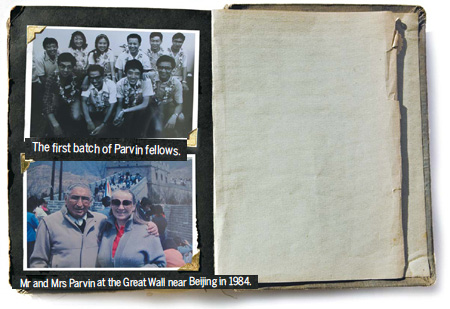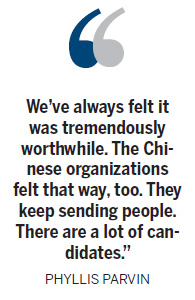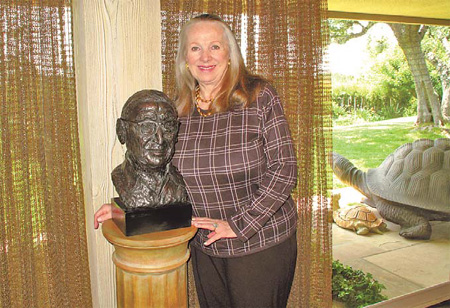Parvin program nurtures media leaders
|
Phyllis Parvin stands next to the bust of Albert Parvin at her Beverly Hills residence. |


Hawaii stint broadens horizons of fellows and brightens their career prospects, reports Li Xing in Los Angeles
Laughter permeated the room as Phyllis Parvin thumbed through an old photo album in her Beverly Hills residence.
The photos brought back the days of more than 30 years ago, when her late husband, philanthropist Albert Parvin (1900-1993), received a letter from Prof John Luter (1919-2000), then journalism department chairman of the University of Hawaii (UH) at Manoa.
The letter led Parvin, with the board members of his foundation and Prof Luter, to start a Albert Parvin Fellowship Program in Journalism at the UH. The program, which is expecting its 31 batch of students in summer, has helped train more than 250 Chinese journalists in the past three decades, according to Gerald Kato, associate professor of journalism at the UH, who has been running the program for the past seven years.
In 30 years, many of the students have become leaders in major Chinese news organizations, such as Xinhua News Agency and China Daily. Zhu Ling, leader of the first class of 10 students, is now editor-in-chief of China Daily. Zhou Shuchun, of the seventh class, is now vice-president of Xinhua News Agency.
Also in 30 years, Mrs Parvin has witnessed great changes in China through the Chinese students and her six visits to China.
"He (Luter) must have written 1,000 letters about the new program involving Chinese students," Mrs Parvin said in an exclusive interview with China Daily.
Prof Luter wrote in the letter: the program was "to play a major, and pioneering, role in training potential leaders among the new generation of journalists in the People's Republic of China", according to Kato in an e-mail to China Daily.
"Al showed it to me, (and asked) 'what do you think'," she recalled, feeling the bronze bust of Mr Parvin with deep emotion.
"At that time, Nixon had already gone to China. China was open to us and we were open to them," she said. "What better way to get to know a huge neighbor than journalism? The press affects everybody."
The board members also endorsed the idea and the next thing everybody knew, the first class of students was arriving in August 1981, Mrs Parvin said.
For the students, everything was new. Fresh graduates from universities in Beijing, six of them had only worked for a month at China Daily, China's new national English language newspaper that was launched only about 12 weeks earlier.
Only a few knew about Walter Lippmann, Bob Woodward or Carl Bernstein. Some had dreamed of becoming diplomats while in college.
Mrs Parvin considered the first class of students to be "initiators of a tremendous movement" along with Mr Parvin and Prof Luter, but none of the students was able to foresee how the Albert Parvin Fellowship would change their lives.
From the first class, Jing Jun moved on to pursue anthropology at Harvard University and is now a well-known professor of sociology at Tsinghua University. A few others have risen in ranks as senior executives of multinational businesses in China or in the US.
They have "ended up in such incredible places. Even if they didn't stay at China Daily, everyone has moved up and beyond", Mrs Parvin said.
In the 30 years, the relations between China and the United States have experienced a lot of ups and downs. "There were also painful moments," David V Polhemus, former editorial writer of the Honolulu Advertiser who taught several classes of Chinese students over the years, wrote in an article published in the Honolulu Advertiser in 2005.
For instance, some students decided to stay in the US, he wrote.
Were there moments of doubts?
"No, not really. We've always felt it was tremendously worthwhile. The Chinese organizations felt that way, too. They keep sending people. There are a lot of candidates," Mrs Parvin said.
The biggest achievement that the program has made is to enable everyone involved to experience change, Mrs Parvin said.
"China has changed tremendously," she said, while looking through the old photos taken during the first trip she and Mr Parvin made to China in 1984. In three weeks, they visited Shanghai, Beijing, Xi'an and Guilin.
In those days, everybody was wearing Mao outfits, she said.
At the Great Wall, they dined in a small restaurant. She still remembered that it was a time when "Coca Cola was still fancy".
In Xi'an, they were able to go down to the pit to measure up the terracotta warriors in different sizes.
In Guilin, they took a trip down the Lijiang River. She said she was amazed that the beautiful mountains along the river, which she'd always taken to be only "artists' idea", did exist.
Then Mr Parvin became ill and immobile. It wasn't until 1994, after Mr Parvin died, that Mrs Parvin made her second trip to China.
She said she was struck by the guide who met them at the airport. "The guide came in a red T-shirt and a mini skirt," she recalled. "Just 10 years. The transition was so dramatic. It has changed so amazingly (that) I couldn't get over it.
"Everything was different, and newer. A lot of the charming old part of the city was gone and cranes were everywhere."
After the 1994 trip, she has traveled to China four more times. During her most recent trip in December, she celebrated her 73rd birthday.
"It is almost impossible to go anywhere without a car," she said. "Once you get in the car, you sit in the traffic. It is mind boggling, particularly when there is not a big history of people driving there. Road rules are not followed. People in the left lanes cut across four lanes, holding off all the traffic, instead of preparing ahead."
The changes in the young students are similarly dramatic from the first class to the latest.
The first group made only about $40 a month back home, she noted. These days, the students have more money and they go to a lot of places, Washington and New York, for instance.
One of the students brought his wife with him, she said, while picking up a purse of woven light blue beads that the wife had made for her.
The students started to teach Chinese to children and even senior Chinese-Americans.
Over the years, she entertained most of the student groups at home and in Los Angeles, before the students returned home. "I have a houseman who loves it when the students are here. He picks them up, takes them through town, takes them to Hollywood, takes them to Disneyland, and he loves showing off LA," she recalled.
The latest group of six students visited her in May. "We had such a nice time. They were so gifted with the language," she said.
In a word, the quality and background of the students have changed, she noted. The program has improved tremendously.
What has not changed is that the students remain "appreciative of the wonderful opportunity", she said. "They still have the same roots."
Local Chinese-American cultural organization still take care of the students, she said.
Mrs Parvin has remained "devoted to the ideals of the Parvin Fellowship Program and continues to support it through these many years", Kato said.
"As anyone who's met her knows, she cares for each and every one of the students who have been fellows," he said. "Her generosity and charm are evident to all those who have attended these events."
Above all, "beyond the journalism training and academic courses all of you have taken here, the interaction with Hawaii's multi-ethnic community and students from around the world at the East-West Center have created a greater awareness and understanding of the West and the rest of the world that have made all the participant-journalists better prepared to report on news of importance to China and the rest of the world," Kato said.
Since the Albert Parvin Foundation was established in 1960, it has supported a number of education programs, Mrs Parvin said.
In the early 1980s, Parvin gave $1 million dollars as seed money for the construction of a new molecular biology building at the University of California at Los Angeles, for Paul D. Boyer, who shared the Nobel Prize in chemistry with John E. Walker and Jens Christian Skou in 1997.
"It seems as if I had won the prize" when news came, Mrs Parvin recalled. "Just the little gifts, and they send wonderful ripples around the world," she mused.
Li Xing is assistant editor-in-chief and chief US correspondent of China Daily. She was among the first batch of Parvin fellows
(China Daily 06/01/2011 page48)















